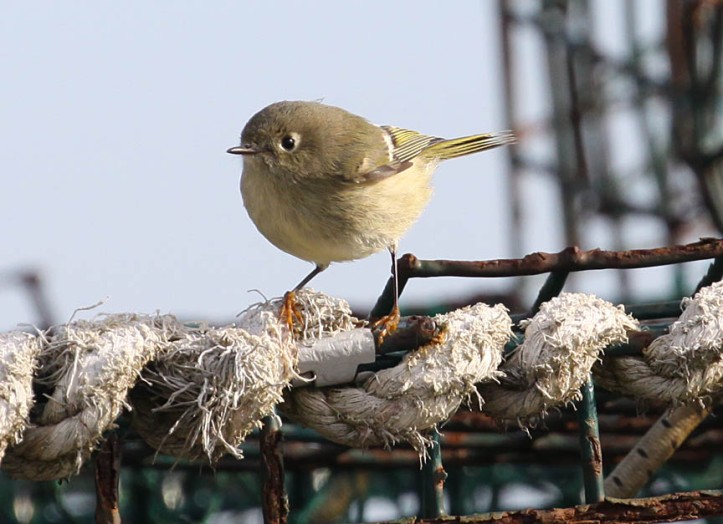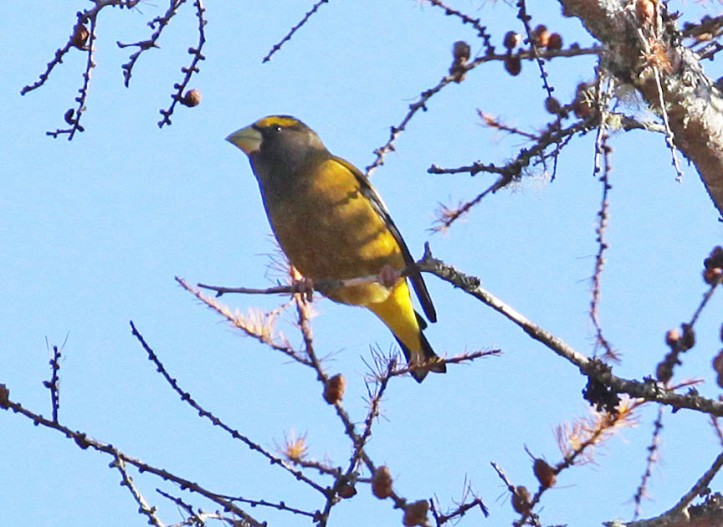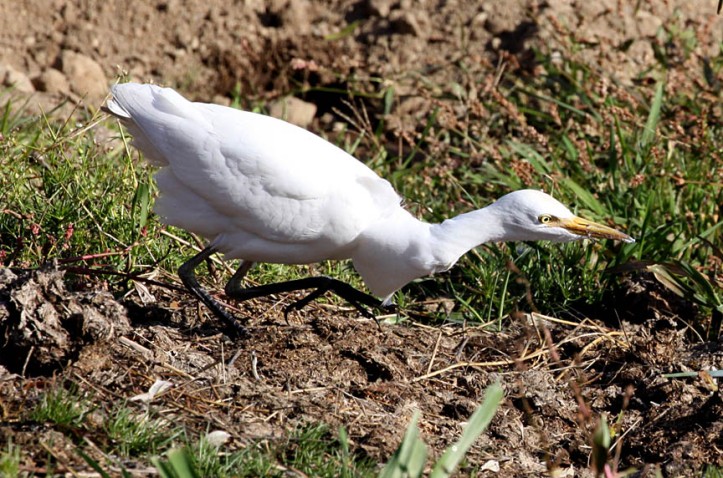This is a long post where I wander off, get on a soap box and then get off it again. Stop after the photos if you like or read on and wince. Apogolies for any spelling errors, Sandra, my word checker, is busy.
It makes no sense, going to the Halifax area and seeing most of the rare birds that were being seen (including the drunken Yellow-billed Cuckoo, Apples for most meals, it wasn’t sick it had a hangover!), but then missing the four big birds in our own area. To refresh your memory, the four big birds in order of disappearance were Calliope Hummingbird (West Pubnico), Townsend’s Solitaire (Argyle), Gyrfalcon (Cape Sable Island) and now Townsend’s Warbler (Barrington).
The first was not gettable, a chance encounter of a great bird for Yarmouth County. The second was possibly gettable but circumstance ganged up on us, just one of those things and no blame suggested or attached. The Gyr, well that was different because I probably saw it on Wednesday November 2nd, it was flying away from me down The Hawk putting up gulls as it went. I drove carefully to the end (in about 45 seconds) but couldn’t see it anywhere. A few days later (November 5th) Johnny had a dark form Gyr over the same area and heading towards the church, he called me. I was at Daniel’s Head, so looked for it coming my way, it didn’t. I was watching a distant blob on the sea and waiting for Mike to show up to see it too, when the Gyr went back over The Hawk and out to The Cape. Subsequent vigils failed to deliver and it must be assumed to have headed off.
Now we come to the Townsend’s Warbler, I am assuming that you know what one is. Ervin, Mike and I went out to The Cape on Wednesday November 9th hoping for the Gyr and anything else that might have south the peace of the island. We peaked with Wilson’s Snipe and the Ruby-crowned Kinglet below. After disembarkation from our transport, Mike and I headed home and Ervin wandered around CSI looking for butterflies. He called me, we had a chat and I suggested, as an option on the way home, Butch Hogg’s Feeders on Petticoat Lane Barrington where a sizeable flock of Evening Grosbeaks had been bankrupting him of Black Sunflower seed.
Ervin called me at 2:35 to tell me that he had seen a Black-throated Green Warbler, a good November bird and he was going to send me a back-of-the-camera image, it never came. He also sent one to Alix who identified it as a Townsend’s Warbler. Ervin called me back with the news and we were off, me driving, Sandra calling the news out. The warbler and other birds had been flushed by a Sharp-shinned Hawk but we were optimistic it would be seen, it wasn’t to dusk. The next day we searched for nearly 6.5 hours, no sign, it has been looked for today (November 11th), no sign.
We did get a Pine Warbler and the Evening Grosbeaks on the 10th, although only 10. This rather dull Baltimore Oriole was also around and had been the original target of Ervin’s lens before the warbler appeared. The plot thickens when we hear that another birder visiting the feeders had seen a Black-throated Green Warbler there about two weeks prior, right at the time when the other western warblers had showed up in the big city.
So has the warbler gone? My gut feeling is no. We saw the Pine once for a few minutes, we also had a singing Red-eyed Vireo that we never saw nor heard again, there are birds there but they are moving in a big and largely inaccessible area. Due diligence demands regular checks, at least until the next ice age, but spending the whole day there is unlikely so we will resort to birder serendipity. The other option is to kidnap ‘lucky’ Ervin and stake him to the ground until it shows up, thinking about it this option seems more appealing by the minute, even if we don’t see it!
Some small compensation for the lack of warbler was the continued presence of the two, but now one Cattle Egret/s on nearby Factory Road. The remaining one is the original, the other one with a buffier crown has wandered elsewhere (and hopefully CSI).
The fact that Ervin photographed the Townsend’s Warbler means he fulfilled the requirement of the three little words that you can expect to hear if you find a good bird, ‘got a photo’. Good means rare, although rare can mean just not that common where the bird was claimed, as opposed to truly rare, a mega. The boon of digital photography has made the answer to the question almost unnecessary as claims, whether eBird submissions, Facebook posts or the old, traditional record submission will inevitably be supported by the ‘evidence’. It gets a bit heavier when the photo then has to pass deeper scrutiny. The card has to be submitted and experts check the validity of the data capture, just to be sure that the species you claim wasn’t snapped where they are common but who would do such a thing, well, every interest has its nut jobs, birding is no different.
There are some pros and cons. The pros are the visual evidence of what you say you saw. The evidence does not have to be great and just about anyone with a cell phone has a camera option, this is why the old U.F.O chestnut has been firmly put to bed. With many millions of devices out there capable of capturing a range of photographic evidence, the presence of extra-terrestrial visitors would, by now, be well-documented, as are most rare birds. A con is that the camera will capture what you say you saw, so you are hide-bound by the digital image that you present, even if it doesn’t quite show what think you know you saw, but this is rare.
As birders we love to see other people’s bird photos, especially the rarities. Our vicarious enjoyment of these photos actually sounds like a form of voyeurism that should have a specialist, dedicated magazine, shrink wrapped and placed on the top shelf with other perv mags (like Guns and Ammo or Trumptasic S & M or… add your own here). We also love to pull to bits the claim when the shot falls short, it is human nature whatever the subject. The question is, are we, as birders, right to place such importance on supporting records with visible evidence over those without, or have we heaved the baby out with the bath water without realising it?
My birding schooling included keeping a notebook and writing descriptions (still do the former, rarely the latter). It would be churlish to insist that nothing but old school works, but I do feel that the absence of notebooks and a reliance on the image has removed a skill that we think we still have, that is field observation. Our world currently breeds short attention spans, a symptom of media education to expect more and then to move on to the next big thing, we get bored. This is why rare birds pique our interest, they are new, different, fresh. With the loss of the writing skills associated with a pen and ink description goes the broader capability to elaborate of what we have seen, namely the rare bird, so we mostly now rely on the image. There is another problem though, the Elephant in the birding room.
Everyone makes mistakes while birding, if you don’t then you are a deity and we all bow to your superiority. Some people are incompetent, this is not a crime either, incompetence as a word is harsh, inexperienced is a bit too far the other way, the PC term would probably be avianly challenged, whatever, mistakes will be made. Then there are two other types of deceivers, self and deliberate. Self-deceivers convince themselves of an identification, often with only the slightest of evidence and their self-deception almost always involves an actual bird, just not the bird they say it is. The others are much more sinister, as they set out to deliberately deceive and they deserve no mercy.
Over what now seems like a lot of years of birding I have known a few selfies. They are usually decent, skilled people sharing the same love of birding as everyone else, but they just don’t quite get where the line is, when to let something go. We’ve all had the same problem, a tail disappearing into a bush never to return, or a fly-over against the light or with just distant views. With experience, the ability to call these birds correctly increases, the same experiences also increases the chance of a successful self-delusion. In truth the odd self-deception is harmless, repeat offending however does skew the ornithological record, and that is the point, the maintenance of a robust ornithological record, but why?
In Montreal recently a group of experienced birders tried to stop a development to protect some vulnerable breeding species and to maintain what has become a very good birding area. A judge heard the case and decided for the developer, no surprise there as our legal system is as crooked as our business sector. What rather shook the senses was the assertion by the legal representatives of the developers that the testimony regarding the status of the birds at the site was flawed because the lead birder was not an expert, when in fact he was, whereas the testimony of the developers ‘expert’ was valid because they had a qualification, a degree. This is not unusual and most such developer legal teams can rent a tame ecologist, everything is for sale. I highlight this case particularly as it used evidence of bird populations as recorded in eBird.
I would say, in terms of qualification, that an eBird record is as watertight as it can be, it needs to be because it may be used to defend against dollar-hungry developers but, eBird has its share of the deceivers, so what can be done about it? The obvious answer is rigorous review of all records, every time, but then the possibility is that the aforementioned baby does fly poor kid. eBird wants, no needs those records, and this is why they have a team of regional reviewers, most highly competent (ours in NS), some not (no comment), some blindly parochial (how many states are there in the US?). So what does a reviewer do when a contributor clearly deceives?
The human answer is to give some slack, sift the wheat from the chaff and be inclusive. The real answer is to bar the deceiver from the eBird party, for good. If you are going to use data as a defence then there can be no chink in the armour, no loose thread for a lawyer to pick at, no room for complacency. I don’t envy those tasked with dealing with this issue, noses and more will be put severely out of joint, but it has to be done and not just for the validity of eBird. There are very many birders out there who see these deceptions and know them for what they are, and they will lose confidence in the system. When that happens strange things can occur, just look at the recent election just over the wall (when it gets finished).
Finally, I trust everyone is studying the new systematic list that will presumably be implemented on eBird at some point. I am working on a blog post about it and about the possible splits (not lumps, we don’t talk about them) and their relationship with the current Nova Scotia bird list, as documented in a recent American Birding Association publication. It may take a while and some research but it should be fun to do and, hopefully, a good read.








“Finally, I trust everyone is studying the new systematic list”
Sounds intriguing; I’ll wait for your post about it to find out what that is.
LikeLike